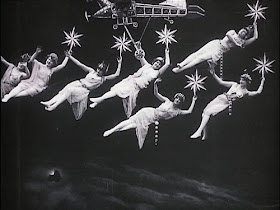As you know, Georges Melies was the father of film special effects. He was also a very great filmmaker. He's in my Pantheon of personal heroes, meaning that any important move I make must in my imagination be layed out before him for his comment and approval. Martin Scorcese's "Hugo" was about Melies and some of the images here are from that film. I thought I'd discuss a few of those images here.
Melies was a terrific artist and his "Trip to the Moon" was full of iconic images. How did he ever come up with the unforgettable image of a row of pretty sailors (above), all holding each other at the waist, and loading a giant canon?
The composition seems crowded. You could argue that the rooftops and girl soldiers at attention were unnecessary. You could argue that the complex composition was uncinematic and too influenced by print media. You could argue that, but you'd be wrong. Melies had a knack for that sort of thing and a knack trumps everything.
The girls wave triumphantly after the capsule's loaded. Melies had live theater experience and knew you had to give the audience a release, a chance to cheer, after a powerful visual image.
Melies was a stage artist with lots of experience in the beautiful cluttered look of Victorian era set design. It's very mannered, but I infinitely prefer this to modernist minimalism.
In real life, stage sets like this (above) would have required awkward blackouts to cover the scene changes. On film Melies had only to cut to a whole new set-up, ready-made. He must have found that liberating.
Melies wasn't the only director to paint the frames of his films, but he was the only one who did it right.
The dyes used for film paint were unrealistic and seemed out of place in ordinary dramas. That kind of theatrical color, with its puffs of crimson smoke, worked best on Melies' kind of fantasy stories.
It's fun to imagine what the NASA lunar astronauts of our own era dreamed when they were falling asleep on the Moon. In the midst of all that sophisticated equipment I'll bet they fell asleep thinking of girls they kissed in cars when they were in school. Melies would have seen the humor in that. Humans are such puny and silly things yet somehow we're also suffused with greatness.
Of course Melies' stars (above) don't hold themselves up. They had to be held up by beautiful girls.
Melies owned a live action theater devoted to magic, and I imagine the sets from his films did double duty as stage backdrops. Geez, wouldn't you have loved to see what the stage shows were like?
Melies was a magician who made movies. There were no rules in those days, filmmakers just did what looked like fun. Now rules dominate. Did you ever see Syd Field's film books? Fields tells you exactly where every beat of the film should fall, and how long it should last [actually, I admire Fields for sticking his neck out like that]. How different things are now!
For his film Scorcese lovingly recreated the energy in the old Melies studio (above).
Steve says Melies' sets were made of painted cardboard.
This is the fate of so many creative people. In order to achieve what they do they have to focus their whole passion and intellect on one thing, then when that one thing is superceded they're reduced to an empty shell. Boy, life can be tough!


















I have tremendous respect for artists like Melies who see potential for creativity and establish something entirely new. I have that same respect for the first animators in the 20s.
ReplyDelete'Hugo' was a huge surprise. I thought it was just melodrama about an orphan in a Paris train station. I'd never heard of Melies before and had no idea the movie was secretly about him.
The scene where we see the fate of his film negatives is shockingly cruel! Even after movies had become a booming industry decades later there was still wanton disregard for film prints and memorabilia.
I saw a documentary about the search for Judy Garlands Ruby Slippers from 'Wizard of Oz'. They were amazed to learn how many costumes, props sets, scripts and paraphernalia was intentionally disposed of by the studio after the movie wrapped. To the studio heads, it was inconceivable that they'd be of any value to anybody.
I remember watching a mini-series on TCM about the history of movies (I think Christopher Plummer was the narrator), and they talked about Melies. Compared to others who were making movies (side note that I thought was funny - some of the original first films were actually pornographic movies!), Melies was WAY AHEAD of his time with special effects and colorization. I remember them mentioning in the documentary about how he ended up in poverty despite the fact that people view him as the inventor of the modern movie.
ReplyDeleteI think that's how life is - the genius comes up with the brilliant ideas but ends up destitute, while some yahoo comes up with a marketing idea based on what the genius did and makes a mint.